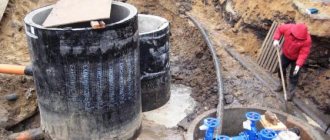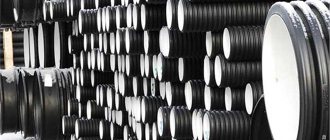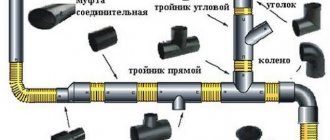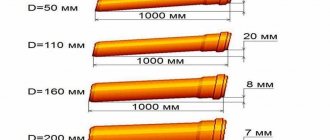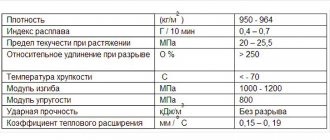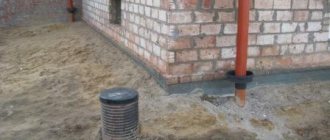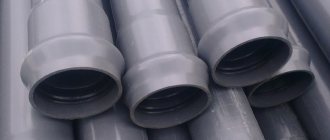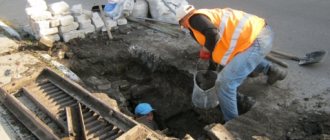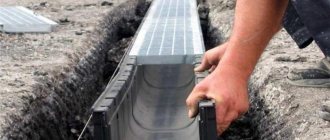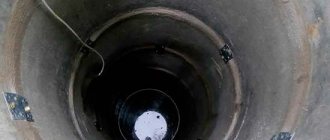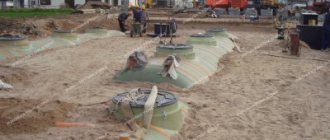After completing all installation work on the sewerage system, it is necessary to test the communication using the spill method. This is done in order to identify defects in the installation of drains, channels, sewer outlets, internal drainage systems, etc. The result of the inspection is included in the act, the form of which is approved by SNiP (Appendix “D” SP 73.13330.2012 “Internal sanitary systems of the building” - updated version of SNiP 3.05.01-85). A similar document in everyday life is called “Act of spillage of the sewer system”; in narrow circles of professionals, the same document has the official name “Act of testing of internal sewerage systems and drains”.
This stage of construction of sewerage communications is mandatory and cannot be cancelled. The verification activities themselves are carried out using the full spill method, provided that at least 75% of the drain holes are opened in a single period of time.
Important: it is possible to put a bunch of sewer outlets into operation only on the basis of an act of carrying out all the proper manipulations and obtaining a positive result.
Below in the material there is an example of how to correctly fill out the document.
Forms of acts for executive documentation
download doc format download doc format download doc format download doc format download doc format download doc format download doc format download doc format download doc format download doc format download doc format download doc format download doc format download doc format download doc format download doc format download format doc download doc format (option 1) download doc format (option 2) download doc format download doc format download doc format download doc format download doc format download doc format download doc format download doc format download doc format download doc format download doc format download format doc download doc format download doc format download doc format download doc format Certificate of commissioning of GRPS download doc format download doc format download doc format download doc format download doc format download doc format download doc format download doc format download doc format download doc format download doc format download doc format download doc format download doc format download doc format download doc format download doc format Certificate of commissioning of GRPS download doc format download doc format download doc format download doc format download doc format download doc format download doc format download doc format download doc format download doc format Certificate of readiness of the foundation (supporting structures) for installation download doc format Certificate of inspection of equipment installation on the foundation download doc format Certificate of internal and external inspection of the boiler before installation download doc format Certificate of hydraulic testing of hot water boilers download doc format download doc format download doc format download doc format download doc format download doc format download doc format download doc format download doc format VSN 478-86 download doc format VSN 478-86 download doc format download doc format VSN 478-86 download doc format download doc format download doc format VSN 478-86 download doc format download format
Sample report on sewer clearance. Persons - members of the commission
After completing the installation work of internal sewerage systems and drains, the installation organization must carry out their tests and draw up a report in accordance with Appendix “D” “Internal sanitary systems of the building” (updated edition of SNiP 3.05.01-85). These tests must be carried out by pouring water by simultaneously opening 75% of the sanitary fixtures connected to the area being tested. The test method gives rise to the “everyday” name of the act – sewer spill act or sewer spill act.
However, the name of the act, according to the regulatory documentation, is the following: act of testing internal sewerage and drainage systems. We have figured out the correct name of the act and its purpose.
Now let’s take a closer look at the form of the test report for internal sewerage and drainage systems and the method of filling it. First, fill in the name of the system on which the tests were carried out.
We take the name of the system from the design documentation.
For example, this could be “domestic sewerage K1”. Next, you need to fill in the name of the capital construction project.
There is nothing complicated here. We take information about the name from the design documentation or construction permit. After this, we enter information about the city in which the capital construction project is located and the date of the tests.
The block in which data about the commission that conducted the tests is entered includes the following information: the name of the customer’s organizations, the general contractor, the installation (construction) organization, as well as the positions, initials and surnames of representatives of these organizations. In paragraph 1 of the test report for internal sewerage and drainage systems, data (name) is entered on the design organization, design documentation code, drawing numbers in accordance with which installation work was performed.
In paragraph 2 we indicate the number of simultaneously open sanitary fixtures and the time during which the tests were carried out. Sanitary fixtures include bathtubs, washbasins, shower trays, drains, bidets, toilets, closet bowls, urinals, sinks, sinks, and drains.
Filling out the act point by point
- Paragraph 1 will contain detailed information about the company that designed the drainage system. The name of the code in which all project documentation was compiled is also included here. In addition, in the first paragraph of the document on testing the sewage system by pouring internal and external communications, it is necessary to enter all the numbers of the drawings that were used during installation for each drainage section.
- Clause 2 of the above-mentioned test report must contain accurate information about the number of simultaneously open sanitary points and the period of time during which the tests took place using the full pressure flow method. According to SNiP, sanitary points include toilets, sinks, bathtubs, showers, bidets, urinals, drains, etc.
Important: at the time of sewer testing, according to SNiP regulations, at least 75% of sanitary points must be open at the same time at the site.
- Clause 3 of the completed report is intended for records of possible violations in the operation of the system. That is, about the occurrence of leaks, stagnation, blockages, etc. If this was not detected at the time of checking the communication, then in paragraph 3 an entry is made that no leaks or other unauthorized deviations in the operation of the sewer system were detected at the time of the test.
- The last section is the decision of the commission, which allows or does not allow the drain to be put into operation depending on the test result obtained.
Important: the signatures of all commission members are required at the bottom of the document. Otherwise, the act will not be considered valid under the law. In addition, any deviations from the form of the act and the principles of its completion are unacceptable.
If obvious deficiencies are found in the communication work, indicating the negligent attitude of the contractor or all organizations accompanying his work, then the organization responsible for the deficiency, according to the law, bears administrative, disciplinary or criminal liability (depending on the identified defect).
External sewerage spill report sample
Electricity Saving Box
You can read reviews here The quality of installed sewage systems in a country house and beyond is checked at all levels.
First of all, all building codes and requirements must be observed. Then the installation is supervised. And at the end, tests are carried out and a sewerage spill report is drawn up, a sample of which can be found on the Internet.
In order to check the functionality, the following is carried out:
- tightness;
- functionality of wells;
- storm sewer system.
- internal system testing;
Internal sewerage consists of plumbing fixtures, which include household appliances with water drainage; all internal pipes, as well as the central pipeline with the drain pipe.
In turn, the external sewerage system consists of pipelines directed from the house to the septic tank, wells and their connections, and treatment facilities. as well as drains for storms and rain.
To inspect the sewerage system, a special commission is assembled from representatives of the following companies:
- laying the sewer network and is responsible for the quality of its work, as well as compliance with current standards;
- who compiled the project and is responsible for all calculations and drawings;
- carried out on-site research and was responsible for information on the climate and environmental situation;
- ordering and supervising all construction and responsible for quality checks when putting the system into operation.
The liability of all organizations is strictly limited to the scope of the work they perform. After the inspection, a sewerage spill report is drawn up, the form of which the representatives usually carry with them. If any errors or shortcomings are discovered, the guilty company is held accountable depending on the severity of the violations identified.
Device for saving electricity Electricity Saving Box You can read reviews here All tests are carried out strictly according to the prescribed sanitary standards and rules called “Sewerage.
Certificate of testing of sewerage systems for the clearance of pipelines.
Sample act for spilling external sewerage
The block in which data about the commission that conducted the tests is entered includes the following information: the name of the customer’s organizations, the general contractor, the installation (construction) organization, as well as the positions, initials and surnames of representatives of these organizations. In paragraph 1 of the test report for internal sewerage and drainage systems, data (name) is entered on the design organization, design documentation code, drawing numbers in accordance with which installation work was performed. In paragraph 2 we indicate the number of simultaneously open sanitary fixtures and the time during which the tests were carried out.
Sanitary fixtures include bathtubs, washbasins, shower trays, drains, bidets, toilets, closet bowls, urinals, sinks, sinks, and drains. During tests in accordance with the rules, at least 75% of the sanitary fixtures connected to the tested area must be open simultaneously.
If the temperature is lower, a pneumatic leak test of pipes and connections is carried out (compressed air). The integrity of the riser, sometimes of external sections of the pipeline, is also determined by air.
We will use the pneumatic testing method to assess the performance of a pressure sewerage system, when wastewater is forced out, under pressure created by pumping equipment. The location of installed plumbing fixtures and its compliance with project documentation is determined visually. The height of the receiver of each device, the correct connection of the toilet drain, siphons of the washbasin, bathtub, sink, etc. are objectively assessed and reflected in the report.
The condition of the plumbing fixtures themselves is also visually assessed.
They must be free of visible dirt and mechanical damage.
- outgoing pipe.
- sewer risers;
In the external part of the sewer system, sections of the pipeline (between cleaning and auxiliary equipment) are tested for leaks, as well as: Advertising
- operability of wells, tightness and slope of the pipeline;
Parties involved in the review
If we are talking about more or less large-scale construction, where several organizations are involved, not counting the customer, tests of sewer systems are carried out by all of them, after which the results are documented in the appropriate inspection report.
Typically, inspection of the sewerage system involves:
- the organization that compiled the project and is responsible for the correctness of calculations and selection of materials and components;
- a company that analyzed climatic and soil conditions and made recommendations for the design of the external components of the sewer system;
- a contractor who was directly involved in installation work related to the laying of internal and external sewer networks and is responsible for compliance of the activities carried out with the project and existing requirements specified in SNiP;
- a customer who controls the correct testing of discharge pipes, connections and some functional units of the sewer network inside the building and in the external section of the wastewater disposal system.
Each of the representatives of the parties participating in the tests and signing the final inspection report is responsible for inaccuracies and shortcomings that arose during testing of sections of the system, individual nodes or the entire network as a whole.
As-built documentation
1 Acceptance certificate for a gas distribution system facility completed by construction, form , 2 Gas pipeline route layout report, example , 3 Pipeline purge report, form , 4 Gas pipeline purge report, example , 5 Visual and measuring inspection report (VII) of welded joints, form , 5a Visual certificate and measuring control VIC, example , 5b Certificate of transmission of vertical mounting joints of the tank wall, form (VSN 311-89), example 5c Certificate of transfer of an oil pipeline section by the customer to the work contractor for major repairs, form , 6 Certificates of transfer of operation of technical devices (GRPSh) etc.), form, . 7 Certificates of transfer of operation of locking devices, form , 8 Certificate of testing of technical devices, form , 9 Certificate of acceptance and transfer of as-built documentation of ITD, example , 10 Certificate of acceptance of a laid and ballasted pipeline, example , 11 Certificate of acceptance into operation of a completed overhaul of a gas pipeline, example , 12 Report on backfilling, deboning of a laid pipeline, example , 13 Report on monitoring the continuity of the insulating coating of a pipeline, example , 14 Report on the results of checking products for compliance with technical specifications.
documentation, example , 15 Report on the results of inspection of IKP products, example , 16 Report on the results of inspection of products, complete visual inspection, example , 17 Certificate of incoming quality control, example , 18 Certificate on the actual quality and ballasting capacity of products, example , 19 Report on preliminary testing of a pipeline, example , 20 Certificate of pneumatic testing of a pipeline for strength, example , 21 Report of pneumatic testing of a gas pipeline, example , 22 Certificate of cavity cleaning and calibration of a gas pipeline, example , 23 Report of preliminary testing of a gas pipeline valve assembly, example , 24 Certificate of inspection of welds , example , 25 Report on the results of incoming inspection of materials and equipment - Bobyshka, example 1 Report on conducting a hydraulic test of a pressure pipeline for strength and tightness, form , 2 Report on washing and disinfection of pipelines KhGSV, form ,
Testing the drainage system outside the building
External sections and nodes of the sewer network are in most cases tested using the hydraulic method
In most cases, external sections and nodes of the sewer network are carried out hydraulically (except for the mentioned situation with low air temperatures). Test objects are:
- pipeline (tightness, slope);
- operability of differential and rotary wells;
- condition of storm sewers (tightness of gutters, drains, ability to drain a given volume of water per unit of time).
The outlet hose is tested like an internal pipeline (spill, compressed air). In pressure sewer networks, the integrity of connections and pipes is checked under pressure. The test is considered positive if the pressure at the inlet and outlet of the system is the same, which indicates the absence of leaks.
Wells are tested by filling them with water. A filled tank with hermetically sealed inlet and outlet openings should not form leaks, that is, the water level in the well should be constant over a certain period of time. Testing of other structures included in the external sewer system (cesspools, septic tanks) is carried out in a similar way. The results of the tightness test are reflected in the report.
Storm sewerage is checked as follows:
- the drain into the common outlet pipe is sealed;
- the system is filled with water (horizontal drains around the perimeter of the roof, vertical drains);
- the result is taken into account after 10 minutes (for metal systems) or after 20 (for plastic);
- a positive result of testing the storm drain is included in the inspection report if the water level has not changed and leaks are not visually detected at the junctions of pipes and fittings.
Important! If a sealant was used when joining storm drainage elements, the system is tested after 24 hours from the date of completion of installation work.
It is necessary to test the sewer system before starting finishing work inside the building and filling trenches and pits outside. Testing allows you to timely find and correct defects made during the installation of sewer pipelines and structures. Operation of the sewerage system is possible if in the final document (inspection report) all tests carried out in accordance with SNiP were successful.
As-built documentation
A19.1 General work log. A19.2 Welding log. A19.3 Author's supervision journal.
A19.4 Incoming quality control log. A19.5 Act for laying out the route with an executive layout diagram.
A19.6 Executive diagram of the trench for laying pipelines. A19.7 As-built survey of the plan and longitudinal profile of underground networks. A19.8 Diagram of welded joints indicating distances on it.
A19.9 Conclusion on the quality of welds.
A19.10 Act on conducting a hydraulic test of the pressure pipeline for strength and tightness. A19.11 Act on conducting a hydraulic test of a free-flow pipeline for leaks.
A19.12 Certificate of flushing (disinfection) of the pipeline.
You may be interested in: A19.13 Conclusion of the sanitary-epidemiological service. A19.14 Test report for external fire-fighting water supply for water flow and performance of fire hydrants. A19.15 Certificate for checking the laying of non-pressure pipelines by looking at the light. You may be interested in: A19.16 Certificate of inspection of engineering support networks. A19.17 Act of hidden work for the development of a trench for laying pipelines.
A19.18 Act of hidden work to prepare the foundation for pipelines. A19.19 Act of hidden work on laying pipelines.
A19.20 Act of hidden work on insulation of pipelines.
A19.21 Act of hidden work on the construction of wells and chambers.
A19.22 Certificate of hidden work for backfilling. You may be interested in: A19.23 Act of hidden work for inspection and testing of fittings.
A19.24 Act of hidden work to seal passages through the walls of wells and chambers. A19.25 Certificates of certification of welding technology, welding equipment, welding materials. A19.26 Documents on certification of the laboratory for quality control of welded joints. A19.27 Certificates and certification protocols for welders.
A19.28 Certificates and passports for the materials and equipment used, sanitary and epidemiological reports, fire safety certificates (can be downloaded).
A19.29
Sewage spill report form
During testing of external sewerage using the spill method, the same document is drawn up as during testing of the internal sewage system. The form of the act itself is not a form of strict reporting and can be drawn up by the customer, contractor or subcontractor. Also, during experiments on an external water drainage system, one of the forms of SNiP 3.05.04-85 can be used, which is a general form of document for acceptance of work performed when installing or repairing a drainage system.
When accepting such work, the tests themselves are carried out first, which can be:
- Hydraulic - only non-pressure drainage systems are exposed to them, be it wastewater pipelines or storm sewers. testing is carried out in areas between wells by filling the system with process water. The tests are carried out in two stages - checking pipes and connections before filling the soil and checking the performance of the entire sewer system after filling the soil. Tests are carried out by pumping water into wells or receiving grids for 30 minutes; during the tests, the performance of the system is measured and the tightness of seams and joints is monitored. Tests may also be performed to determine the ability of pipes and connections to withstand the maximum allowable pressure throughout the entire drain.
- Pneumatic - during such tests, the ability of the waste system to withstand the design pressure is checked, according to GOST standards or design documentation. For such a series of studies, specialized organizations with the necessary equipment and licenses are involved; the process itself includes checking the pressure in the system or in its individual sections when supplying air under pressure.
If during the experiments the entire system met the standard indicators of SNIP 3.05.04-85, then an acceptance certificate for the work performed is drawn up, otherwise a defective statement and a drainage troubleshooting report are drawn up. During periodic monitoring at enterprises with drinking water pipelines, external drainage systems are also tested during disinfection or treatment with special reagents.
Sewerage units and systems to be tested
The entire sewerage system in each building is divided into an internal sewerage network and an external sewerage system
The entire sewerage system in each building is divided into an internal sewage disposal network and an external sewerage system. Internal sewer wiring includes the following components to be checked:
- plumbing fixtures and their connections with outlet pipes;
- local sections of a horizontal pipeline with pipes flowing into it from plumbing fixtures;
- sewer risers;
- outgoing pipe.
In the external part of the sewer system, sections of the pipeline (between cleaning and auxiliary equipment) are tested for leaks, as well as:
- operability of wells, tightness and slope of the pipeline;
- condition of treatment or storage facilities (reservoirs);
- storm sewer.
Sewer spill act
During testing of external sewerage using the spill method, the same document is drawn up as during testing of the internal sewage system. The form of the act itself is not a form of strict reporting and can be drawn up by the customer, contractor or subcontractor. When accepting such work, the tests themselves are carried out first, which can be:
- Pneumatic - during such tests, the ability of the waste system to withstand the design pressure is checked, according to GOST standards or design documentation. For such a series of studies, specialized organizations with the necessary equipment and licenses are involved; the process itself includes checking the pressure in the system or in its individual sections when supplying air under pressure.
- Hydraulic - only non-pressure drainage systems are exposed to them, be it wastewater pipelines or storm sewers. testing is carried out in areas between wells by filling the system with process water. The tests are carried out in two stages - checking pipes and connections before filling the soil and checking the performance of the entire sewer system after filling the soil. Tests are carried out by pumping water into wells or receiving grids for 30 minutes; during the tests, the performance of the system is measured and the tightness of seams and joints is monitored. Tests may also be performed to determine the ability of pipes and connections to withstand the maximum allowable pressure throughout the entire drain.
If during the experiments the entire system met the standard indicators of SNIP 3.05.04-85, then an acceptance certificate for the work performed is drawn up, otherwise a defective statement and a drainage troubleshooting report are drawn up.
Also, during experiments on an external water drainage system, one of the forms of SNiP 3.05.04-85 can be used, which is a general form of document for acceptance of work performed when installing or repairing a drainage system.
During periodic monitoring at enterprises with drinking water pipelines, external drainage systems are also tested during disinfection or treatment with special reagents.
Form for testing the internal sewage system.
Sample act for spilling external sewerage
Testing of the internal sewage system should be carried out by passing water by opening three quarters of all sanitary fixtures at the same time.
All water fittings must be directly connected to the section of the pipeline on which the tests are performed for the entire time necessary for its inspection. The system is considered to have passed the test, provided that the inspection does not reveal the presence of leaks through the connection points, seals and walls of the pipelines. Branch pipelines sewerage systems laid in the ground and in channels under the ceilings are tested until they are closed by filling them with water up to the floor level of the 1st floor of the building. When testing sections of sewerage pipelines hidden during further work, water is spilled until they are closed and compiled certificate for the inspection of hidden work. Testing of the internal storm sewerage system is carried out by filling it with water to the level of the highest level of the drainage funnel.
The duration of the test is about ten minutes. The drainage system is considered to have successfully passed the test if during the inspection no traces of leakage were revealed and the liquid level in the risers did not decrease. If you had an emergency with the sewerage caused by damage to the pipeline structure and after calling the appropriate service, the integrity of the system was restored to you by replacing part of the pipeline , the first thing you should check is the tightness of your system.
This indicator is fundamental when it comes to the service life of the sewer system.
Not only old sewers after reconstruction, but also new systems before putting them into operation are subject to leak testing.
If your drainage system is not sealed, this will guarantee trouble for the owner of the sewerage system and his immediate neighbors. In order to avoid possible negative consequences, the sewerage system must pass a series of reliability tests, including the act of sewerage spillage.
Filling out a report on hidden work in the sewer system
After the free-flow sewer system and water supply system have been completely installed and have been tested for sealing by pouring the system, it is also necessary to inspect the communications before closing the entire system. Such work is called hidden and is carried out inside the sewer network. The documented inspection is certified through an inspection report of the sewer pipes before closing.
Such a test (research) is carried out for external pipelines of water supply and free-flow sewerage in order to identify the slightest defects that could ultimately lead to depressurization of the sewerage system and subsequent environmental disaster on a district/city/region scale.
Important: an inspection of the sewerage/water supply system for the purpose of its final commissioning must be carried out as part of a full commission. About who should participate in the inspection and how exactly the sewer network inspection report is filled out, see our material below.
For a detailed explanation, attached is a sample form for an inspection report of the wastewater system after a major pipeline spill to identify violations in the sealing of the system.
Sewer test report for spillage
After completing the installation work of internal sewerage systems and drains, the installation organization must carry out their tests and draw up a report in accordance with Appendix “D” “Internal sanitary systems of the building” (updated edition of SNiP 3.05.01-85). These tests must be carried out by pouring water by simultaneously opening 75% of the sanitary fixtures connected to the area being tested.
The test method gives rise to the “everyday” name of the act – sewer spill act or sewer spill act. However, the name of the act, according to the regulatory documentation, is as follows: an act of testing internal sewerage and drainage systems.
We have figured out the correct name of the act and its purpose. Now let’s take a closer look at the form of the test report for internal sewerage and drainage systems and the method of filling it.
First, fill in the name of the system on which the tests were carried out.
We take the name of the system from the design documentation. For example, this could be “domestic sewerage K1”.
Next, you need to fill in the name of the capital construction project. There is nothing complicated here. We take information about the name from the design documentation or construction permit.
After this, we enter information about the city in which the capital construction project is located and the date of the tests.
The block in which data about the commission that conducted the tests is entered includes the following information: the name of the customer’s organizations, the general contractor, the installation (construction) organization, as well as the positions, initials and surnames of representatives of these organizations. In paragraph 1 of the test report for internal sewerage and drainage systems, data (name) is entered on the design organization, design documentation code, drawing numbers in accordance with which installation work was performed. In paragraph 2 we indicate the number of simultaneously open sanitary fixtures and the time during which the tests were carried out.
Sanitary fixtures include bathtubs, washbasins, shower trays, drains, bidets, toilets, closet bowls, urinals, sinks, sinks, and drains.
Correctness of filling out the act point by point
The first entry that is made in the act is the name of the communication that will be tested in the presence of a special commission. The name without distortion can be rewritten from the project documentation. This could be a storm sewer or a domestic sewer.
The next paragraph of the sewerage system test report should include detailed information about the facility on which the sewerage system is installed. The name of the object, its location address and area are also taken from the project documentation. The date of testing is also indicated here.
External sewerage test report for spillage + sample
» » During testing of external sewerage using the spill method, the same document is drawn up as during testing of the internal sewage system.
The form of the act itself is not a form of strict reporting and can be drawn up by the customer, contractor or subcontractor. When accepting such work, the tests themselves are carried out first, which can be:
- Hydraulic - only non-pressure drainage systems are exposed to them, be it wastewater pipelines or storm sewers. testing is carried out in areas between wells by filling the system with process water. The tests are carried out in two stages - checking pipes and connections before filling the soil and checking the performance of the entire sewer system after filling the soil. Tests are carried out by pumping water into wells or receiving grids for 30 minutes; during the tests, the performance of the system is measured and the tightness of seams and joints is monitored. Tests may also be performed to determine the ability of pipes and connections to withstand the maximum allowable pressure throughout the entire drain.
- Pneumatic - during such tests, the ability of the waste system to withstand the design pressure is checked, according to GOST standards or design documentation. For such a series of studies, specialized organizations with the necessary equipment and licenses are involved; the process itself includes checking the pressure in the system or in its individual sections when supplying air under pressure.
If during the experiments the entire system met the standard indicators of SNIP 3.05.04-85, then an acceptance certificate for the work performed is drawn up, otherwise a defective statement and a drainage troubleshooting report are drawn up.
Also, during experiments on an external water drainage system, one of the forms of SNiP 3.05.04-85 can be used, which is a general form of document for acceptance of work performed when installing or repairing a drainage system.
Sample act for spilling external sewerage. Testing sewerage for spillage and snip standards
After completing the installation work of internal sewerage systems and drains, the installation organization must carry out their tests and draw up a report in accordance with Appendix “D” “Internal sanitary systems of the building” (updated edition of SNiP 3.05.01-85).
These tests must be carried out by pouring water by simultaneously opening 75% of the sanitary fixtures connected to the area being tested.
The test method gives rise to the “everyday” name of the act – sewer spill act or sewer spill act. However, the name of the act, according to the regulatory documentation, is the following: act of testing internal sewerage and drainage systems.
We have figured out the correct name of the act and its purpose. Now let’s take a closer look at the form of the test report for internal sewerage and drainage systems and the method of filling it. First, fill in the name of the system on which the tests were carried out.
We take the name of the system from the design documentation. For example, this could be “domestic sewerage K1”. Next, you need to fill in the name of the capital construction project.
There is nothing complicated here. We take information about the name from the design documentation or construction permit.
After this, we enter information about the city in which the capital construction project is located and the date of the tests. The block in which data about the commission that conducted the tests is entered includes the following information: the name of the customer’s organizations, the general contractor, the installation (construction) organization, as well as the positions, initials and surnames of representatives of these organizations. In paragraph 1 of the test report for internal sewerage and drainage systems, data (name) is entered on the design organization, design documentation code, drawing numbers in accordance with which installation work was performed.
In paragraph 2 we indicate the number of simultaneously open sanitary fixtures and the time during which the tests were carried out. Sanitary fixtures include bathtubs, washbasins, shower trays, drains, bidets, toilets, closet bowls, urinals, sinks, sinks, and drains.
Methods for testing sections of internal sewerage
What and how is checked when checking the compliance of the internal network with the project and established standards is described in SNiP “Sewerage. Internal and external networks and structures." According to this fundamental construction document, the following parameters of the sewer system are subject to inspection inside the building and then reflected in the final document (inspection report):
- testing network pipes for strength and their connections for tightness;
- compliance of the location of installed instruments and elements of the outlet pipeline with the design documentation;
- correct installation of plumbing fixtures in relation to the floor surface (the distance from the floor to the upper edge of the receiver of each plumbing fixture is specified in the above-mentioned SNiP);
- the presence of a slope in the horizontal sections of the pipe and the degree of verticality of the risers.
Testing of pipes and connections for leaks in a gravity system, regardless of the material of the pipeline and fittings, is carried out using the spill method. The essence of the technique is that part of the main pipeline (bed) is fenced off in a certain area from the rest of the system. This is done with special plugs through inspection holes. The separated area is checked by filling it with water through the pipes of plumbing fixtures. According to SNiP, the results of a spill deserve attention if the pipeline was filled with the participation of at least ¾ (or 75%) of all devices connected in a given isolated section. Testing of the pipeline using the spill method is considered positive if the connections after filling the system did not give the slightest leak within 10-15 minutes (depending on the volume of the area filled with water).
According to the regulatory documentation, a spill, that is, testing a sewer system by filling it with water, is informative when the air t˚ is above 5˚. If the temperature is lower, a pneumatic leak test of pipes and connections is carried out (compressed air). The integrity of the riser, sometimes of external sections of the pipeline, is also determined by air. We will use the pneumatic testing method to assess the performance of a pressure sewerage system, when wastewater is forced out, under pressure created by pumping equipment.
The location of installed plumbing fixtures and its compliance with project documentation is determined visually. The height of the receiver of each device, the correct connection of the toilet drain, siphons of the washbasin, bathtub, sink, etc. are objectively assessed and reflected in the report. The condition of the plumbing fixtures themselves is also visually assessed. They must be free of visible dirt and mechanical damage.
The correct slope of the pipes inside and outside the building is controlled using a building bubble level. If the slope of the internal sewer network is allowed to be at least 1 cm per linear meter, then on the outside this figure must be increased to 2 cm per meter.
The installation position of the riser (this data is also reflected in the final report) is checked with a plumb line. A deviation from the vertical of 3˚ is allowed. A water tightness test of the riser is also carried out. The pressure should be about 0.8 MPa.
in Ivanovo
About the company+7 Pumping out sludge, cleaning car washes, pumping out wells, septic tanks and cesspools.
21 May '19
Guarantee of the best price for new MTKs in stock* Economy from RUB 14,000.
(incl. VAT) | Standard from 17,000 rub. (including VAT) Rental of dry toilets Short-term and long-term rental of dry toilet cabins Liquids for dry closets Universal environmentally friendly products for dry closets Sewage pumping Pumping of septic tanks and toilets, removal of reinforced waste by sewage truck from 800 rubles Any type of rental and maintenance of toilet cabins in Ivanovo and region B The cost of short-term rental includes: delivery and installation, unloading and loading, special refueling. liquid and toilet paper, waste removal for disposal.
from 13,900 rubles Sale of mobile toilet cabins in Ivanovo and Ivanovo region Sale of mobile toilet cabins with delivery and the possibility of further maintenance, as well as sale of shower cabins and portable washbasins.
from 300 rubles Portable dry toilets and consumables for them Portable dry closets for country holidays, as well as a wide range of consumables
from 400 rubles per 1 m3 Sewage disposal: pumping out cesspools, septic tanks and settling tanks We have a license for the collection and transportation of liquid household and industrial waste of hazard class 4, we enter into contracts with organizations for the removal and disposal of solid waste.
RUR 15,000/month Autonomous wheel washers for construction sites The installation allows for recycling water supply for wheel washing without polluting the natural environment and does not require connection to a water supply.
